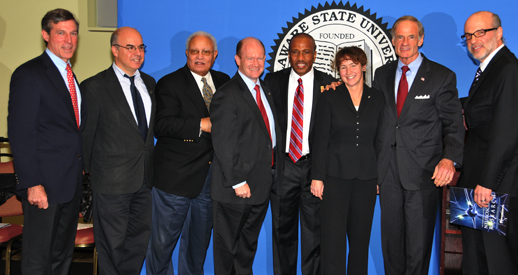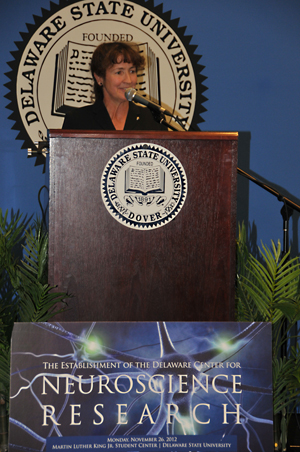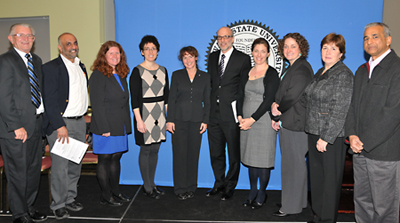
DSU Awarded a School-Record $10.5M Grant for Neuroscience Research
|
|
|
|
-
Dr. Harb Dhillon, DSU associate professor of biology – Understanding the molecular basis of learning and memory using C. elegans.
-
Dr. Amy Griffin, UD assistant professor of psychology – Role of the rodent medial prefrontal cortex in behavioral plasticity.
-
Dr. Anna Klintsova, associate professor of psychology, UD – Fetal Alcohol Syndrome model: therapeutic interventions.
-
Dr. Tania Roth, UD assistant professor of psychology – Lasting epigenetic influence of early-life adversity on the BDNF gene.
-
Dr. Cindy van Golen, DSU associate professor of biology – CXCR4 controls neurite extension through direct regulation of actin dynamics.
-
Dr. Sunil K. Agrawal, UD professor of mechanical engineering – Robotic navigation inspired by neuromechanics of C. elegans.
-
Dr. Rachel Pulverman, DSU assistant professor of psychology – Infant verb learning: from attention to comprehension
-
Dr. Theresa Szabo-Maas, DSU assistant professor of biology -- DSU influence of environmental and hormonal changes on mechanisms of motor learning.
-
Dr. Georgianna Gould will join DSU as an assistant professor of biology in January 2013. Her research focuses on the development of social behavior in a mouse model of autism.


 Dr. Melissa Harrington, professor of neuroscience and the principal investigator of the NIH grant.
Dr. Melissa Harrington, professor of neuroscience and the principal investigator of the NIH grant. DSU and UD researchers that will benefit from the grant: Leonard Davis, chair of the DSU Dept. of Biology; Dr. Harbinder Dhillon, DSU asst. professor of biology; Dr. Cynthia VanGolen, asst. professor biology; Dr. Rachel Pulverman, DSU asst. professor of psychology; Dr. Melissa Harrington, grant principal investigator and DSU professor of neuroscience; Dr. Jeff Rosen, UD professor of psychology and grant co-principal investigator; Dr. Amy Griffin, UD asst. professor of psychology; Dr. Tania Roth, UD asst. professor of psychology; DR. Anna Klintsova, UD associate professor of psychology; and Dr. Sunil K. Agrawal, UD professor of mechanical engineering.
DSU and UD researchers that will benefit from the grant: Leonard Davis, chair of the DSU Dept. of Biology; Dr. Harbinder Dhillon, DSU asst. professor of biology; Dr. Cynthia VanGolen, asst. professor biology; Dr. Rachel Pulverman, DSU asst. professor of psychology; Dr. Melissa Harrington, grant principal investigator and DSU professor of neuroscience; Dr. Jeff Rosen, UD professor of psychology and grant co-principal investigator; Dr. Amy Griffin, UD asst. professor of psychology; Dr. Tania Roth, UD asst. professor of psychology; DR. Anna Klintsova, UD associate professor of psychology; and Dr. Sunil K. Agrawal, UD professor of mechanical engineering.